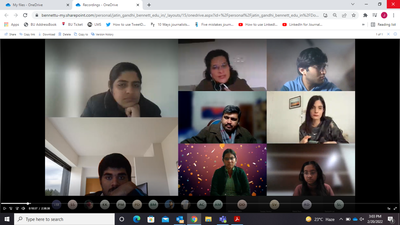What is RTI Act and how should you file it
Times of Bennett | Updated: Feb 21, 2022 10:52

By Abhipsa Choudhury
LeadingRTI Expert and Activist Anjali Bhardwaj believes that in a democracy, there should be “very few secrets” and if the government is really ‘of’ and ‘by’ the people, then all the records that they generate should be available to the citizens at an arm’s-length.
Bhardwaj made this observation while delivering a guest lecture on ‘RTI 101’, organised by Times School of Media on January 25.
Bhardwaj, who is the founder of Satark Nagrik Sangathan, a citizens’ group working to promote accountability and transparency in governance, said that, “The ground problem has always been thatinformation is absolute power, and government s don’t want to share that power with the citizens. If anybody went to a government office to seek information , he would never be provided that”.
India among Top 10 RTI nations
India is “among the top 10 countries in the world to have a highly progressive Right to Information Act”, because well informed citizens and NGOs played an active role in drafting it,” Bhardwaj said.
Even though the law was passed in 2005, Bhardwaj said that theSupreme Court , from the 1970s-80s, had given many judgements in which it upheld people’s right to information and said that ‘Right to Information’ flows from Article 19 of the Constitution, which deals with freedom of speech and expression.
What exactly is the RTI Act of 2005?
According to Bhardwaj, ‘Right to Information’ means the right to all the accessible information that falls under this act, which is held by or under the control of any public authority and includes the right to:
1. Inspection of work, documents and records
2. Taking notes, extracts, or certified copies of documents or records
3. Obtaining information in the form of tapes, cassettes, floppies, discs, or in any other electronic mode or through printouts, where any such information could be stored in a computer or any other electronic device.
Who uses the RTI Act and for what?
Bhardwaj says that “each year, nearly 6 million RTI Applications are being filed, mostly by the poorest and the marginalised to access information about their basic rights and entitlements.” She also said that RTI law has empowered citizens to hold the government and its functionaries accountable and “is used by people to question the highest offices and unearth scams.”
How accessible and practical is the RTI Act?
This act, according to Bhardwaj, has made information universally accessible to the citizens of India, especially the poor. Also,
1. The fee to file an RTI application is low.
2. There are Assistant Public Information Officers at sub-district levels to facilitate filing of applications/appeals.
3. There’s no need to specify any reason for seeking information or other personal details.
4. There is a provision in the Act to provide all required assistance, including to ‘sensorily-disabled people’.
5. Information has to be provided in local languages for better comprehension.
How can a RTI query be filed?
1. The RTI application along with the desired information that the citizen wants to know in a question format has to be submitted in writing, with prescribed fee to the regional Public Information Officer (PIO). The answerable information must be provided within 30 days. 2. RTI application can also be filed digitally on www.rtionline.gov.in by paying a nominal fee. Also, each state has its own dedicated site for easy filing in regional language as well.
( The writer is a student of Post-graduate Diploma in Digital Journalism.)
Join exciting programmes offered by Bennett University
Leading
Bhardwaj made this observation while delivering a guest lecture on ‘
Bhardwaj, who is the founder of Satark Nagrik Sangathan, a citizens’ group working to promote accountability and transparency in governance, said that, “The ground problem has always been that
Even though the law was passed in 2005, Bhardwaj said that the
What exactly is the RTI Act of 2005?
According to Bhardwaj, ‘Right to Information’ means the right to all the accessible information that falls under this act, which is held by or under the control of any public authority and includes the right to:
1. Inspection of work, documents and records
2. Taking notes, extracts, or certified copies of documents or records
3. Obtaining information in the form of tapes, cassettes, floppies, discs, or in any other electronic mode or through printouts, where any such information could be stored in a computer or any other electronic device.
Who uses the RTI Act and for what?
Bhardwaj says that “each year, nearly 6 million RTI Applications are being filed, mostly by the poorest and the marginalised to access information about their basic rights and entitlements.” She also said that RTI law has empowered citizens to hold the government and its functionaries accountable and “is used by people to question the highest offices and unearth scams.”
How accessible and practical is the RTI Act?
This act, according to Bhardwaj, has made information universally accessible to the citizens of India, especially the poor. Also,
1. The fee to file an RTI application is low.
2. There are Assistant Public Information Officers at sub-district levels to facilitate filing of applications/appeals.
3. There’s no need to specify any reason for seeking information or other personal details.
4. There is a provision in the Act to provide all required assistance, including to ‘sensorily-disabled people’.
5. Information has to be provided in local languages for better comprehension.
How can a RTI query be filed?
1. The RTI application along with the desired information that the citizen wants to know in a question format has to be submitted in writing, with prescribed fee to the regional Public Information Officer (PIO). The answerable information must be provided within 30 days. 2. RTI application can also be filed digitally on www.rtionline.gov.in by paying a nominal fee. Also, each state has its own dedicated site for easy filing in regional language as well.
( The writer is a student of Post-graduate Diploma in Digital Journalism.)
Join exciting programmes offered by Bennett University







